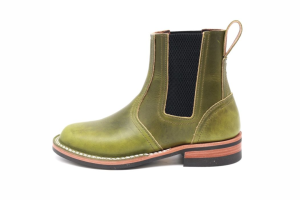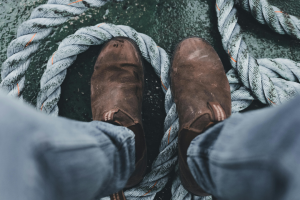Effective Ways To Protect Your Feet From Winter’s Chill

Key Takeaways:
- Materials And Craftsmanship Matter: Full-grain leather boots paired with thick rubber soles provide unmatched durability, insulation, and comfort for winter conditions.
- Layering And Moisture Control Are Essential: Proper socks and moisture management strategies help maintain warmth by wicking away sweat and preventing cold, wet feet.
- Care And Accessories Enhance Performance: Waterproofing your boots, using insoles, and adding accessories like gaiters ensure long-lasting protection and comfort in winter.
It’s necessary.
Cold weather can make even a short walk unbearable without the right gear. Keeping your feet warm is essential for protecting your health and enjoying the season.
At Nicks Boots, we know that quality footwear is an investment. Our handcrafted boots, made from full-grain leather and built to last, combine durability and comfort to easily tackle the harshest winters.
In this piece, we’ll examine effective strategies on how to keep your feet warm during winter’s chill, like selecting high-quality boots made with full-grain leather to layering techniques to maximize insulation.
Understanding The Challenges Of Winter Foot Warmth
Keeping your feet warm in winter is a battle against the elements. Freezing temperatures can quickly drain body heat, especially if your footwear lacks proper insulation. Add moisture from snow, slush, or sweat; your feet can become cold and dangerously exposed to frostbite and other health risks. The combination of cold and wet conditions requires careful planning to ensure your feet stay warm, dry, and comfortable.
High-quality boots crafted from full-grain leather, like those from Nicks Boots, offer superior durability and protection against winter’s harshest conditions. Unlike synthetic materials, leather naturally regulates temperature and resists water when adequately treated, making it ideal for cold-weather wear.


Choosing The Perfect Pair Of Winter Boots
Selecting the proper boots for winter is crucial for keeping your feet warm, dry, and comfortable in freezing temperatures. Material quality, design, and craftsmanship determine how well your boots perform in extreme weather. Understanding the features of winter-ready boots helps you choose a pair that suits your needs and withstands icy conditions.
Why Full-Grain Leather Matters
Full-grain leather is an exceptional choice for winter boots because it offers durability, natural insulation, and breathability. Its ability to wick moisture prevents sweat from accumulating, reducing the risk of cold feet even during extended use. When appropriately treated, full-grain leather also resists water and shields your feet from snow, slush, and other wet conditions.
Importance Of Proper Boot Construction
High-quality boot construction ensures optimal protection and performance in freezing weather. Look for boots with triple stitching or welted soles for enhanced durability and the ability to withstand heavy wear. Paired with thick rubber soles, this meticulous construction ensures warmth, water resistance, and excellent traction on icy or slippery terrain.
Benefits Of Rubber Soles
Rubber soles provide excellent insulation, creating a barrier that prevents heat loss and keeps feet warm. Their slip-resistant properties ensure stability on icy surfaces, making them an essential feature for winter footwear. When paired with leather uppers, rubber soles complete a rugged, winter-ready boot ideal for tackling harsh outdoor conditions.
Layering With Warm Socks For Maximum Insulation
Layering with the right socks is as important as choosing the right boots to warm your feet in winter. Socks are the first defense against the cold by trapping heat and wicking away moisture. Below, we’ll explore how to select the best socks for warmth and comfort:
- Materials That Trap Heat: Wool is the gold standard for winter socks because it retains warmth even when wet. Unlike cotton, wool wicks moisture away from your skin, keeping your feet dry and insulated. Opt for socks made from merino wool, as they are softer and less likely to irritate during extended wear.
- Thickness and Fit: The thickness of your socks can greatly influence your overall warmth. Thick socks provide extra insulation but should not be so bulky that they restrict blood circulation or make your boots too tight. Choose socks that fit snugly yet comfortably, ensuring optimal warmth without compromising movement.
- Layering for Extreme Cold: Consider layering your socks for protection in extreme conditions. Start with a moisture-wicking base layer, like thin merino wool or synthetic liner socks, and add a thicker wool sock. This combination creates an effective barrier against cold and moisture, ensuring maximum warmth.
- Avoiding Cotton Socks: While cotton socks are common, they should be avoided in winter as they retain moisture rather than wicking it away. Wet socks can quickly lower the temperature of your feet, leading to discomfort and potential health risks like frostbite. Opting for materials like wool or high-performance synthetics is a much better choice for winter warmth.
- Maintaining Sock Quality: Proper care of your socks ensures they perform well over time. Wash wool socks with gentle detergents and avoid high-heat drying to prevent shrinking or damage to the fibers. Well-maintained socks last longer and retain their ability to trap heat and wick moisture effectively.
Importance Of Moisture Management
Moisture can significantly lower your foot temperature from external sources like snow or sweat. Let’s break down effective ways to manage moisture and keep your feet warm and comfortable:
Choose Moisture-Wicking Socks
Moisture-wicking socks, especially those made from merino wool or synthetic blends, are essential for winter footwear. These materials draw sweat away from your skin, keeping your feet dry and reducing the risk of cold-related discomfort. Avoid cotton socks, as they retain moisture and can make your feet colder.
Treat Leather Boots For Water Resistance
Even high-quality full-grain leather boots need proper care to prevent water penetration. Use a waterproofing treatment to create a barrier against snow, slush, and rain. Nicks Boots offers boots built for durability, and with the proper treatment, they can repel moisture effectively while maintaining breathability.
Use Boot Liners For Additional Protection
Boot liners can provide an extra moisture management layer in wet or snowy conditions. Liners help wick sweat away from your feet while providing a barrier between moisture and the inner surface of your boots. This dual-purpose solution ensures dry and warm feet even in harsh environments.
Additional Tips For Keeping Feet Warm Outdoors
While high-quality boots, warm socks, and insoles are essential, a few extra precautions can make a significant difference in keeping your feet warm outdoors. These tips focus on maximizing heat retention and ensuring long-lasting comfort during winter activities:
Keep Moving To Boost Circulation
Engaging in physical activity increases blood flow, which helps maintain warmth in your feet even in cold conditions. If you’re stationary for extended periods, try wiggling your toes or standing up to walk around briefly to stimulate blood flow. Regular movement prevents cold feet and reduces the stiffness and discomfort often experienced in icy weather.
Use Foot Warmers For Extreme Cold
In freezing weather, foot warmers can offer a consistent and dependable heat source to keep your feet warm. These disposable or rechargeable devices fit inside your boots and provide hours of warmth, making them invaluable for outdoor activities in freezing temperatures. Always ensure your boots are roomy enough to accommodate these warmers comfortably without squeezing your feet.
Avoid Tight-Fitting Footwear
Wearing overly tight boots or piling on too many socks can restrict blood flow, counteracting your efforts to keep your feet warm. Opt for boots that fit well but allow space for an insulating layer without creating pressure points. Maintaining proper circulation through a snug but comfortable fit is crucial in keeping your feet warm and preventing cold-related issues.
Dry Feet After Each Outing
Even the most durable boots and high-quality socks can accumulate moisture after a day spent outdoors. After returning inside, promptly remove your footwear and let your boots and socks dry thoroughly to prevent dampness from compromising insulation. This simple practice helps maintain warmth and reduces the risk of conditions like athlete’s foot.
Wear Gaiters For Snow Protection
Gaiters provide a protective barrier that prevents snow, slush, and debris from entering your boots and soaking your socks. Sealing the area between your boots and pants helps maintain dryness and warmth in snowy or wet environments. Gaiters are especially beneficial for winter hiking, snowshoeing, or any activity requiring prolonged exposure to deep snow.


Final Thoughts
Winter’s chill doesn’t have to mean cold, uncomfortable feet. Prioritizing warmth and protection is essential for your well-being and enjoyment during the colder months. Choosing high-quality, full-grain leather boots and pairing them with the right socks keeps your feet warm and safeguards them from moisture and harsh conditions. These steps ensure you're prepared to face winter, regardless of the activity or environment.
Read also:
Frequently Asked Questions About How To Keep Feet Warm In Winter
What are the best materials for winter boots to keep feet warm?
Full-grain leather is one of the best materials for winter boots as it offers durability, natural breathability, and excellent insulation. This material provides warmth and long-term resilience, making it perfect for cold weather.
How do layering socks help in cold weather?
Layering socks helps trap heat and manage moisture by using multiple insulating barriers. A thin, moisture-wicking layer prevents sweat buildup, while a thick wool sock adds warmth and cushioning.
Are thicker soles better for warmth in winter boots?
Thicker soles create a greater barrier between your feet and the cold ground, which helps retain heat. They also provide extra comfort and shock absorption, making them ideal for icy or rugged terrain.
Can I wear winter boots for long hikes?
Yes, winter boots made with durable materials and sound support can be excellent for hiking. Look for boots with full-grain leather and traction-enhancing soles to handle snowy and uneven trails.
How can I keep my boots waterproof in winter?
Regularly applying waterproof treatments, such as waxes or sprays, helps maintain the leather’s ability to repel water. Keeping the boots clean and conditioned also ensures long-lasting protection in wet conditions.
What is the role of gaiters in winter footwear?
Gaiters shield the tops of your boots and lower legs from snow, slush, and debris, keeping your feet dry and warm. They’re especially beneficial for activities like snowshoeing or hiking in deep snow.
Why is circulation essential for keeping feet warm?
Healthy circulation delivers warm blood to your feet, helping to maintain their temperature. Tight boots or overly layered socks can restrict blood flow, making it harder for your feet to stay warm.
How do I know if my boots are warm enough for winter?
Warm winter boots typically feature insulating materials, thick soles, and a snug fit for socks without compression. Additional features like waterproofing and breathability can further enhance their effectiveness.
Are synthetic materials suitable for winter boots?
Synthetic materials can provide warmth but often lack the breathability and longevity of full-grain leather. Leather offers better natural insulation and durability for demanding winter conditions.
Can I use the same boots for winter work and casual wear?
Yes, versatile boots like those from Nicks Boots are stylish enough for casual wear and durable enough for work. Their craftsmanship ensures both function and aesthetic appeal in cold weather.




